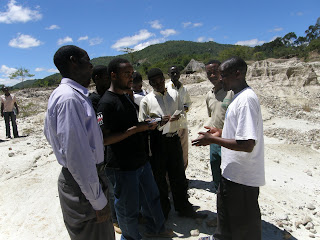Mr. Mohammed Mngoma told a group of students from Tumaini University including journalists who visited the site that, southern highland region of Tanzania is lagging behind in terms of tourism development. According to him, the region though it’s endowed with lots of tourism potentials seem to have been forgotten in terms of media publicity an aspect that little is known about the region by people of Tanzania and even outside.

A tour guide at Isimila stone age site, Mr. Donatus Lihoha explaining a point to students of Tumaini University during their tour of the site.
The northern circuit that includes the regions of Arusha, Manyara, Kilimanjaro and Mara are given wider publicity compared to the southern circuit, and because of this there is a great need for the media professionals in the country to help promote the southern circuit. Isimila Stone Age site is one of the historic and a wonderful sites in East Africa whereby the discoveries of stone tools believed to have had been used by ancient people during early stone age about 300,000 years ago were discovered in 1951. According to Mr. Mngoma, his site has been excavated by archeological experts from various universities mostly in USA in a series of three excavation works since pre-independence time, but little has been exposed to the local people on the importance of the site. The site which has 33 hectares of land has become an attraction for tourists who regularly visit the area not only to see samples of stone age tools, but also to view a number of standing natural earth pillars formed as a result of soil erosion in an extended bend of a 2 km gorge that formed a valley thousands of years back.

Students from Tumaini University of Iringa peering through a little hut on which different varieties of stones believed to have been used by ancient hunters were preserved at Isimila stone age site about 20 km away on the outskirts of Iringa town.
Concerning with the recent development made at the site, since the year 2007, the site has undergone major improvements by opening up a site museum and an information centre. The museum represents human development activities in the area from as early as Acheulian period to the present. The area has become one of the most tourist sites in the country attracting over 25,000 visitors per year, both local and foreign tourists. A great number of foreign tourists comes from the USA, UK and German. The fees for the entrance to the site varies, foreigners pays Tshs. 3,000/- per person while an ordinary Tanzanian who is not a student pays Tshs. 1,000/-. Students from higher learning institutions pays Tsh. 500/- while students from secondary schools and pupils from primary schools pays Tsh 200/- each. The Isimila site museum therefore present ethnographic, historical and archeological material from the Southern Highlands region of Tanzania purposely to highlight people’s ingenuity as manifested by material culture showing technological continuity and innovations.











No comments:
Post a Comment